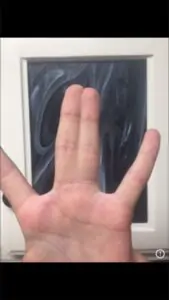What is Syndactyly? Causes, Symptoms, and Treatments
- Dr Maryum Sohail
- February 15, 2024
- 10:26 pm

Syndactyly is the presence of webbed digits in youngsters. Syndactyly is a condition where at least two fingers or toes combine. Syndactyly is a birth-related condition in which youths are carried into the world with joined or webbed fingers. It is in the hands of approximately half of the children. More often than not, syndactyly influences the fingers, yet syndactyly of the toes can likewise be seen.
How Normal Is Syndactyly?
Syndactyly or merged fingers is a typical disease. It is the most considered common innate hand deformation in pediatric people, impacting around 100 in every 2,500 kids. Young fellows are affected more than young women, and whites are affected more than dull or Asian youngsters.
What Are The Side Effects of Syndactyly?
Syndactyly can occur between any two fingers, but it is most common between the middle and ring fingers. At times, the melded digits may nearly look like solitary fingers. In contrast, in others, the fingers might be associated with a skin fold that looks like webbing.
Are All The Syndactyly Same?
- Syndactyly may be simple, meaning only soft tissues may be involved without bony connections between the fused or webbed digits.
- Complex syndactyly is the one in which there is a side-to-side complete connection between the involved digits.
- It may also be complete syndactyly, wherein the skin extends to the fingertips, or incomplete, where the skin does not extend to the fingertips.
- Syndactyly may sometimes be associated with medical syndromes, but that is occasional.
Also, Cheack: metatarsus adductus
What Causes The Digits To Be Webbed?

During pregnancy, a baby’s hand is formed as a paddle and later split into separate fingers. This Happens early on in the developmental phase of the child, around 6-8 weeks of pregnancy.
If two or more fingers do not separate at this time, syndactyly occurs. Syndactyly is a condition that often runs in families and has a genetic predisposition, which means that about 40% of children will inherit the condition from a parent. Sometimes, the condition is a hereditary disorder like Apert or Poland’s.
How Is Syndactyly Treated?
Most babies with syndactyly of the toes do not need surgery; they can walk and ruin well. In the case of syndactyly of the hand, however, surgery offers an improved chance of hand function. Release of syndactyly is usually done between the ages of 1 and 2 years for the child to optimize the use of hand function for daily activities and before there is development of hand dominance in children.
During the surgery, skin is split evenly between the two fingers; however, on certain occasions, a child may require a graft or a skin substitute to cover the newly separated finger, which is usually taken from the abdomen, elbows, or upper arm. This is typically the case if the child is older during surgery.
Suppose multiple digits are involved in the syndactyly process. In that case, the procedure is performed in 2 stages, meaning that one side of the digit is released at a time to avoid compromising vascularity.
The digits with significant length differences are released first to avoid growth disturbances. In the case of bilateral hand involvement, release can be performed simultaneously if the child is small. However, if the child is more than 1.5 years old, the syndactyly release must be staged.
Also, Check: development dysplasia of hips a guide for the parents
What Happens After The Surgery For Syndactyly Release?
After syndactyly discharge, the kid wears a cast or wrap covering the hand and lower arm for 2-3 weeks to keep the hand still and safeguard the mending skin; following the evacuation of the cast, support is normally given to keep the fingers separated.
Does My Youngster Require Any Treatment After Medical Procedure?
The doctors usually recommend occupational therapy after systemic release to reduce scarring and improve hand function.
Does Syndactyly-Release Surgery Have Any Side Effects?
Some children who have had the surgery experience a condition called WEB CREEP. It may occur early on after surgery and is most commonly caused by necrosis of the tip of the flap or loss of skin graft placed in the web area. Late creep is driven by growth discrepancy between the scar and graft tissue, making it look like syndactyly is returning. This complication is more common when the digits are separated before the age of 1 year.
In summary, syndactyly is a webbing or fusion of digits that can be complete or incomplete, being the most common type of birth deformity seen in children. Treatment is usually carried out between one year and 18 months. It consists of the separation of the webbed fingers. Children with syndactyly can do all the usual things as their peers.
Dr Maryum Sohail
Subscribe to Dr Owais YouTube channel
For parenting advice, child health, symptoms, causes and treatment of illness in children.







